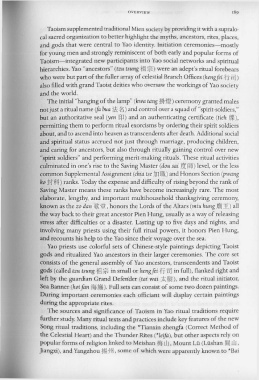Page 229 - The Encyclopedia of Taoism v1_A-L
P. 229
OV ERVI EW
Taoism supplemented traditional Mien society by providing it with a supralo-
cal sacred organization to better highlight the myths, ancestors, rites, places,
and gods that were central to Yao identity. Initiation ceremonies- mostly
for young men and strongly reminiscent of both early and popular forms of
Taoism-integrated new participants into Yao social networks and spiritual
hierarchies. Yao "ancestors" (tzu tsung t-£l. *) were an adept's ritual forebears
who were but part of the fuller array of celestial Branch Offices (hengfei 1T E )
also filled with grand Taoist deities who oversaw the workings of Yao society
and the world.
The initial "hanging of the lamp" (kwa tang j1~ :m) ceremony granted males
not just a ritual name (fa bua 1!~) and control over a squad of "spirit-soldiers,"
but an authoritative seal (yen EP) and an authenticating certificate (tieh !l*),
permitting them to perform ritual exorcisms by ordering their spirit soldiers
about, and to ascend into heaven as transcendents after death. Additional social
and spiritual status accrued not just through marriage, producing children,
and caring for ancestors, but also through ritually gaining control over new
"spirit soldiers" and performing merit-making rituals. These ritual activities
culminated in one's rise to the Saving Master (dou sai JJ[ gjji) level, or the less
common Supplemental Assignment (chia tse :boIl) and Honors Section (pwang
ko iH4) ranks. Today the expense and difficulty of rising beyond the rank of
Saving Master means these ranks have become increasingly rare. The most
elaborate, lengthy, and important multihousehold thanksgiving ceremony,
known as the zo dan ~~ , honors the Lords of the Altars (miu hung !WiT ) all
the way back to their great ancestor Pien Hung, usually as a way of releasing
stress after difficulties or a disaster. Lasting up to five days and nights, and
involving many priests using their full ritual powers, it honors Pien Hung,
and recounts his help to the Yao since their voyage over the sea.
Yao priests use colorful sets of Chinese-style paintings depicting Taoist
gods and ritualized Yao ancestors in their larger ceremonies. The core set
consists of the general assembly of Yao ancestors, transcendents and Taoist
gods (called tzu tsung ** in small or hengfei 1'J'§J in full), flanked right and
left by the guardian Grand Defender (tai wai :t)ff,j), and the ritual initiator,
Sea Banner (hoi fan "fflJJIi). Full sets can consist of some two dozen paintings.
During important ceremonies each officiant will display certain paintings
during the appropriate rites.
The sources and significance of Taoism in Yao ritual traditions require
further study. Many ritual texts and practices include key features of the new
Song ritual traditions, including the *Tianxin zhengfa (Correct Method of
the Celestial Heart) and the Thunder Rites (*leifa), but other aspects rely on
popular forms of religion linked to Meishan ;j1jJ L1J , Mount Lii (Liishan F-n L1J ,
]iangxi), and Yangzhou m j'I'1 , some of which were apparently known to *Bai

